 THE SPREAD OF THE
PROTESTANT REFORMATION
THE SPREAD OF THE
PROTESTANT REFORMATION
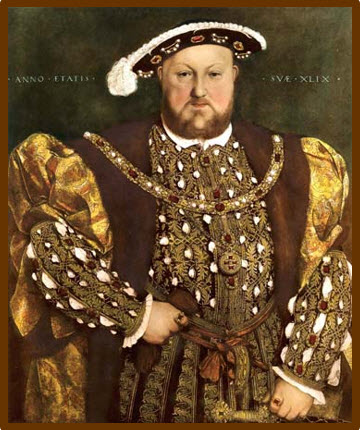
Henry VIII:
King of England
Unit
Overview
The
Protestant Reformation, which had caught fire in Germany, spread across
Europe. Reformers, such as John Calvin
and John Knox, combined the ideas of Martin Luther with their own
interpretation of Christianity. Henry
VIII refused to accept the pope’s authority and set the stage for religious
change in England. This resulted in new
churches and different forms of worship.
It also led to major disagreements among European Christians. At the same time, the Roman Catholic Church
launched the Catholic Reformation in an attempt to slow the advancement of
Protestantism. Let’s see how it all
happened.
John
Calvin and the New Generation of Reformers
By
1520, the concept of religious change had swept over Europe, and a new
generation of reformers built on the ideas of Martin Luther. John
Calvin, a native of France, was one of the most influential. Trained as a Catholic priest and as a lawyer,
Calvin published his book Institutes of the Christian Religion
in 1536. It explained his beliefs and
offered advice on how to set up a Protestant church. This book became very popular and was widely
read by Protestants all over Europe. The
citizens of Geneva, Switzerland were
so impressed by his writings that they asked John Calvin to lead their
community. Calvin agreed and established
a theocracy, a form of government
run by church leaders. The Calvinists
stressed the importance of hard work, self-discipline, saving money and
honesty. People came from all over
Europe to visit Geneva and to see first-hand the effects of Calvinism.
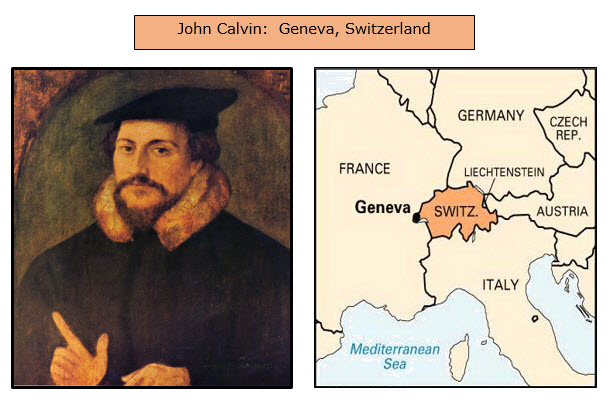
The
ideas of John Calvin spread as Protestants returned home and shared their observations. New Christian sects, such as the Anabaptists,
took root in communities throughout Europe.
The concepts that inspired reformers, however, threatened Roman
Catholics, and armed conflict over religious issues became increasingly
common. In Scotland, a Calvinist
supporter named John Knox led a
religious rebellion. Scottish
Protestants overthrew their Catholic queen and set up the Scottish Presbyterian
Church. At the same time, Calvinists
called Huguenots battled with
Catholics in France. Wars continued in the
German states between Catholics and Protestants and between Calvinists and
Lutherans. England, too, would
experience a break with the Roman Catholic Church. In this case, however, it happened more for
political and personal reasons rather than religious ones.
Henry
VIII and the Church of England
When
Henry VIII, king of England, first
heard of the ideas expressed by Martin Luther, he wrote a pamphlet that
emphasized just how wrong Luther was. Pope Leo X was so impressed with the
king’s efforts that he awarded him the title Defender of the Faith. In
1527, Henry’s personal life and the issue of a male error transformed his
relationship with the Roman Catholic Church.
As a young prince, Henry had entered into an arranged marriage with Catherine from Aragon, a province in
Spain. Once he became king, Henry VIII
was convinced that a stable government depended on a male heir or a son to
inherit the throne. Although he and Catherine
had been married for eighteen years, the queen’s only surviving child was a
girl called Mary Tudor.
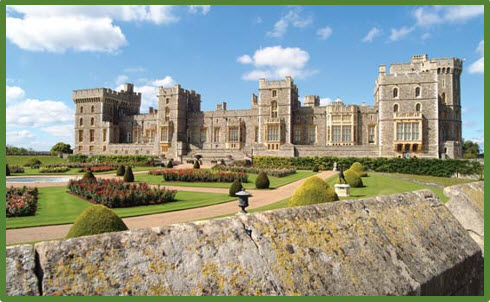
Windsor
Castle: Rumored to Be Haunted by the
Ghost of Henry VIII
Since
it seemed unlikely that he would have a son if he remained married to Catherine,
Henry wanted to divorce her and to marry Anne
Boleyn. Since the laws of the
Catholic Church did not permit divorce, the king asked Pope Clement VII for an annulment. This would cancel his marriage to Catherine
and would give Henry the freedom to marry Anne.
Popes had granted these types of requests for royal families in the past
so Henry assumed it would not be a problem.
In this instance and at this time, it was. Catherine’s nephew was none other than Holy
Roman Emperor Charles V, who had
agreed with Rome’s condemnation of Martin Luther. Not wanting to offend his ally, the pope
refused to okay the annulment.
Henry
VIII was determined to divorce Catherine in spite of the pope’s ruling. He called a meeting of Parliament and asked
the assembly to pass several new laws concerning the Church. The Act
of Supremacy, which went into effect in 1534, officially made Henry, not
the pope, the head of the Church of England.
Anyone who refused to accept this law was executed for treason. The king appointed his friend Thomas Cranmer as the Archbishop of
Canterbury. The new archbishop gave
Henry his annulment and permission to marry Anne Boleyn. Much to Henry’s disappointment, she did not
produce a son but one daughter named Elizabeth.
Eventually, Henry VIII married four more times. Jane
Seymour, his third wife, gave birth to Henry’s only son, Edward.
To
gain support for his break with Rome, Henry closed all of England’s monasteries
and seized their lands. Since
monasteries owned almost one-third of all English property, this undertaking
increased his royal power and the royal treasury. Henry sold large amounts of
this land to the nobles and members of the middle class. As a result, the new landowners stood to lose
their property if England returned to the Catholic Church. This gave Henry some solid support for
England’s Protestant Reformation. In most
ways, however, Henry continued to be more of a Catholic than a Protestant. Although he permitted the scripture to be
read in English, he insisted that services and celebrations remain the same.
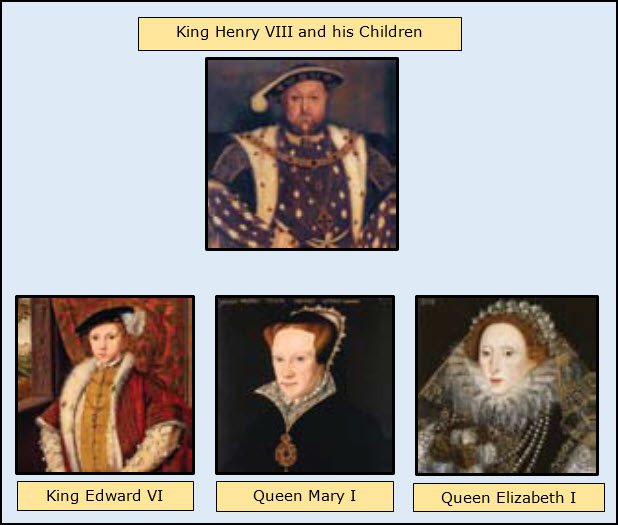
After
Henry VIII died in 1547, all three of his children eventually ruled England,
and each one had a strong religious viewpoint.
First, his son, who was only ten at the time, was crowned Edward VI. His advisors encouraged Parliament to pass
laws that made the Church of England more Protestant. Although the changes were minor, they
resulted in several Catholic uprisings that were harshly put down. Since Edward died as a teenager, his sister
Mary Tudor became queen. Queen Mary I wanted to bring England
back to the Catholic Church. Under her
rule, thousands of Protestants were burned at the stake, including Archbishop
Thomas Cranmer. Mary’s reign was brief,
and her sister Elizabeth inherited
the throne. After ten years of religious
turmoil, the new queen worked to achieve compromises between Catholics and
Protestants with the goal of ending the violence. During her forty-five years as queen or the Elizabethan Era, Elizabeth I kept most
Catholic traditions but affirmed that England was a Protestant nation under the
control of the English crown.
The
Counter Reformation
As
the Protestant Reformation continued to spread, the Roman Catholic Church
recognized that it had to make certain changes if it was going to survive. The driving force behind this movement, known
as the Counter or Catholic Reformation,
was Pope Paul III. From 1530 through 1550, he tried to stop the
Protestant momentum by working to end corruption and by listening to reformers. To establish guidelines for what needed to be
done, the pope called a meeting of European Catholic bishops and
archbishops. Called the Council of Trent, it met on and off for
the next twenty years.
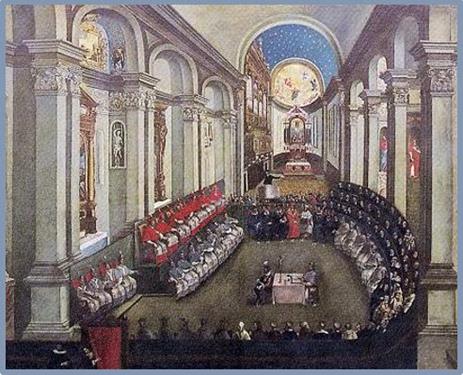
An Artist's Rendition of the Council of Trent
Through
the efforts of this assembly, traditional Catholic values were reaffirmed and
explained. The council recognized the
need for a clergy that was better educated and prepared to answer questions
from Protestants. With this in mind, it passed
measures that provided better training for priests. The assembly also took steps to correct
abuses and to end corruption. At the
same time, Pope Paul III strengthened the power of the Inquisition or Church courts.
To obtain evidence, however, it often relied on secret testimony and
torture. The Inquisition handed down harsh punishments that often resulted in
the execution of the accused. The Church
courts were responsible for compiling and updating the Index of Forbidden Books. These works, including those of Martin Luther
and John Calvin, were considered inappropriate for Catholics to read.
To
counteract the criticism by Protestants concerning monasteries and convents,
Pope Paul III approved a new religious order known as the Society of Jesus or the Jesuits. The group was founded by Ignatius of Loyola, a Spanish knight. After his leg was severely injured in battle,
Ignatius could do little but read as he recuperated. He chose stories about men and women who had
endured mental and physical torture to defend their faith. This inspired Ignatius to organize the
Jesuits, a group of men dedicated to religious training and strict obedience to
the Church. Its members made it their
mission to uphold and spread the Roman Catholic faith throughout the
world. They provided a positive image of
the Roman Catholic Church by serving as teachers, advisers to rulers and
missionaries.
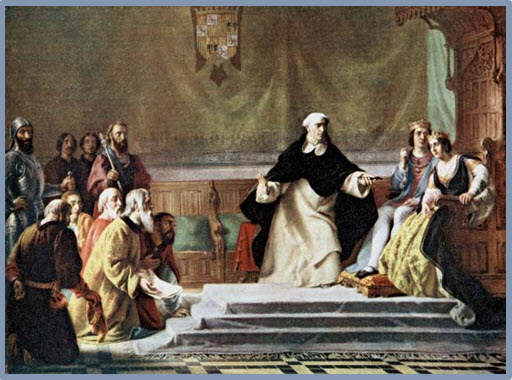
An Artist's Rendition of the Inquisition
In
some respects, the Counter Reformation was a success. The Council of Trent prohibited the sale of
indulgences and other controversial practices.
Church leaders began to focus more on spiritual issues and less on
worldly concerns. Groups like the
Jesuits stressed the importance of understanding one’s faith and the
significance of charity through service.
While these measures improved the Church’s image, other factors, such as
the Inquisition and the Index of Forbidden Books, did not. Nonetheless, the advance of Protestantism
slowed, and some who had left the Roman Catholic Church returned. However, Europe remained divided on issues
concerning the Christian faith as the world entered the Modern Age.
What
Happened Next?
While
Europeans dealt with the events that took place during the Middle Ages and the
Renaissance, other regions of the globe developed their own economies,
governments and cultures. Improvements
in technology, transportation and communication connected Europe with Asia,
Africa and the Middle East, and this resulted in a new era of human history
known as the Frist Global Age. Before
moving on to the next unit, review the names and terms found in Unit 23; then,
answer Questions 21 through 30.